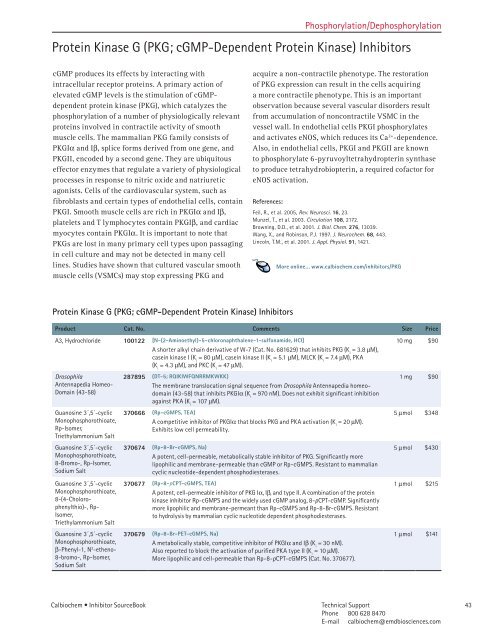Inhibitor SourceBook™ Second Edition
Inhibitor SourceBook™ Second Edition
Inhibitor SourceBook™ Second Edition
You also want an ePaper? Increase the reach of your titles
YUMPU automatically turns print PDFs into web optimized ePapers that Google loves.
Calbiochem • <strong>Inhibitor</strong> SourceBook<br />
Phosphorylation/Dephosphorylation<br />
Protein Kinase G (PKG; cGMP-Dependent Protein Kinase) <strong>Inhibitor</strong>s<br />
cGMP produces its effects by interacting with<br />
intracellular receptor proteins. A primary action of<br />
elevated cGMP levels is the stimulation of cGMPdependent<br />
protein kinase (PKG), which catalyzes the<br />
phosphorylation of a number of physiologically relevant<br />
proteins involved in contractile activity of smooth<br />
muscle cells. The mammalian PKG family consists of<br />
PKGIa and Ib, splice forms derived from one gene, and<br />
PKGII, encoded by a second gene. They are ubiquitous<br />
effector enzymes that regulate a variety of physiological<br />
processes in response to nitric oxide and natriuretic<br />
agonists. Cells of the cardiovascular system, such as<br />
fibroblasts and certain types of endothelial cells, contain<br />
PKGI. Smooth muscle cells are rich in PKGIa and Ib,<br />
platelets and T lymphocytes contain PKGIb, and cardiac<br />
myocytes contain PKGIa. It is important to note that<br />
PKGs are lost in many primary cell types upon passaging<br />
in cell culture and may not be detected in many cell<br />
lines. Studies have shown that cultured vascular smooth<br />
muscle cells (VSMCs) may stop expressing PKG and<br />
acquire a non-contractile phenotype. The restoration<br />
of PKG expression can result in the cells acquiring<br />
a more contractile phenotype. This is an important<br />
observation because several vascular disorders result<br />
from accumulation of noncontractile VSMC in the<br />
vessel wall. In endothelial cells PKGI phosphorylates<br />
and activates eNOS, which reduces its Ca 2+ -dependence.<br />
Also, in endothelial cells, PKGI and PKGII are known<br />
to phosphorylate 6-pyruvoyltetrahydropterin synthase<br />
to produce tetrahydrobiopterin, a required cofactor for<br />
eNOS activation.<br />
References:<br />
Protein Kinase G (PKG; cGMP-Dependent Protein Kinase) <strong>Inhibitor</strong>s<br />
Feil, R., et al. 2005, Rev. Neurosci. 16, 23.<br />
Munzel, T., et al. 2003. Circulation 108, 2 72.<br />
Browning, D.D., et al. 200 . J. Biol. Chem. 276, 3039.<br />
Wang, X., and Robinson, P.J. 997. J. Neurochem. 68, 443.<br />
Lincoln, T.M., et al. 200 . J. Appl. Physiol. 91, 42 .<br />
Product Cat. No. Comments Size Price<br />
A3, Hydrochloride 100122 [N-(2-Aminoethyl)-5-chloronaphthalene-1-sulfonamide, HCl]<br />
A shorter alkyl chain derivative of W-7 (Cat. No. 68 629) that inhibits PKG (K i = 3.8 mM),<br />
casein kinase I (K i = 80 mM), casein kinase II (K i = 5. mM), MLCK (K i = 7.4 mM), PKA<br />
(K i = 4.3 mM), and PKC (K i = 47 mM).<br />
Drosophila<br />
Antennapedia Homeo-<br />
Domain (43-58)<br />
Guanosine 3´,5´-cyclic<br />
Monophosphorothioate,<br />
Rp-Isomer,<br />
Triethylammonium Salt<br />
Guanosine 3´,5´-cyclic<br />
Monophosphorothioate,<br />
8-Bromo-, Rp-Isomer,<br />
Sodium Salt<br />
Guanosine 3´,5´-cyclic<br />
Monophosphorothioate,<br />
8-(4-Choloro-<br />
phenylthio)-, Rp-<br />
Isomer,<br />
Triethylammonium Salt<br />
Guanosine 3´,5´-cyclic<br />
Monophosphorothioate,<br />
b-Phenyl- , N 2 -etheno-<br />
8-bromo-, Rp-Isomer,<br />
Sodium Salt<br />
More online... www.calbiochem.com/inhibitors/PKG<br />
287895 (DT-5; RQIKIWFQNRRMKWKK)<br />
The membrane translocation signal sequence from Drosophila Antennapedia homeodomain<br />
(43-58) that inhibits PKGIa (K i = 970 nM). Does not exhibit significant inhibition<br />
against PKA (K i = 07 mM).<br />
370666 (Rp-cGMPS, TEA)<br />
A competitive inhibitor of PKGIa that blocks PKG and PKA activation (K i = 20 mM).<br />
Exhibits low cell permeability.<br />
370674 (Rp-8-Br-cGMPS, Na)<br />
A potent, cell-permeable, metabolically stable inhibitor of PKG. Significantly more<br />
lipophilic and membrane-permeable than cGMP or Rp-cGMPS. Resistant to mammalian<br />
cyclic nucleotide-dependent phosphodiesterases.<br />
370677 (Rp-8-pCPT-cGMPS, TEA)<br />
A potent, cell-permeable inhibitor of PKG Ia, Ib, and type II. A combination of the protein<br />
kinase inhibitor Rp-cGMPS and the widely used cGMP analog, 8-pCPT-cGMP. Significantly<br />
more lipophilic and membrane-permeant than Rp-cGMPS and Rp-8-Br-cGMPS. Resistant<br />
to hydrolysis by mammalian cyclic nucleotide dependent phosphodiesterases.<br />
370679 (Rp-8-Br-PET-cGMPS, Na)<br />
A metabolically stable, competitive inhibitor of PKGIa and Ib (K i = 30 nM).<br />
Also reported to block the activation of purified PKA type II (K i = 0 mM).<br />
More lipophilic and cell-permeable than Rp-8-pCPT-cGMPS (Cat. No. 370677).<br />
0 mg $90<br />
mg $90<br />
5 mmol $348<br />
5 mmol $430<br />
mmol $2 5<br />
mmol $ 4<br />
Technical Support<br />
Phone 800 628 8470<br />
E-mail calbiochem@emdbiosciences.com<br />
43



